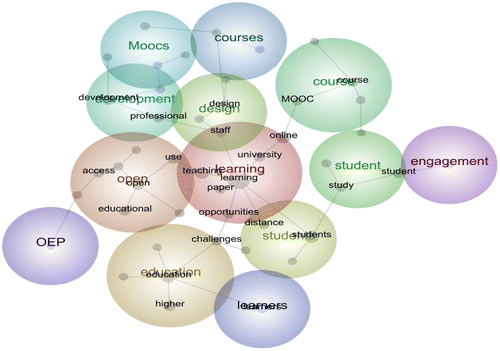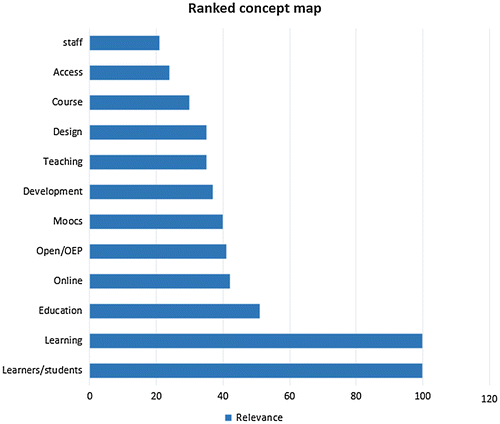This issue of the journal is devoted to a selection of papers to the ODLAA conference held in Melbourne, Australia in Febraury 2017. In order to analyse the content of the presentations at the conference, we have decided to make use of the Leximancer text analysis tool. Leximancer presents visually, a concept map of the text data being analysed and has been used in various other studies (Roberts, Citation2016; Zawacki-Richter & Naidu, Citation2016)
The titles and abstracts of all the papers that were presented at the conference were collated and analysed and the results of this analysis are discussed in this editorial. Taking into account the overall vision for the conference which was ‘Expanding horizons in Open Distance Learning: Open education, community and innovation’, we will discuss the relevance of each of the articles in this edition to the themes that have been identified in Leximancer (Figure ).
From Figure it can be seen that several key concepts were presented at the conference. At the heart of any ODL institution should be the students and their learning, and this is reflected in the analysis of the abstracts. In Figure , similar concepts were grouped together i.e., learner and student, as well as opennes and Open Educational Practices (OEP). As expected, MOOCs made a familiar appearance as well as online learning. Other significant concepts presented at the conference included, the development nature of ODL, course design and staff development.
The articles constitute a clear narrative in line with contemporary issues in the area of distance education. The article by Daniel Burgos and one by Laura Marquez-Ramos examine learning, students and teaching. Burgos looks at transgenic learning for Science, Technology and Engineering, Arts and Mathematics (STEAM) subjects. The article provides a practical view of transgenic learning. It focuses on the limits of the delivery of open and enriched learning content corresponding to university level students. In an environment where advances in the use of technology to enhance teaching has taken a lead role, the article presents ideas that have been tested in the classroom and found to work. Students and staff will find ideas presented here useful. Laura Marquez-Ramos’s article examines ways in which technology has taken over numerous aspects of our lives. The author provides several examples to illustrate her point. For instance she points at the emergence of services provided by the Uber transportation system and Uber Eats representing a system for ordering food online. Further the article explores Airbnb, an online network addressing homestay for travellers. The author makes the point that while people live their physical lives, they still increasingly connect on multiple dimensions through social networking sites. Modern society faces the challenge of being innovative, creative or entrepreneurial.
While one part of the society has gone highly digital, there is another part of the world struggling with the new affordances. This is largely so in the developing countries where direct access to the internet still remains a challenge. Their fate is captured by studies whose focus is on bridging the gap between the digital world and the world trying to catch up with technology. The articles by Mathew Hillier and Richard Musita and colleagues, Betty Obura and Dorine Lugendo, address the challenge of connectivity in distance education. While internet connectivity may remain a challenge in the developing countries, it is also a challenge in some parts of the developed world. In his article, Hillier points to parts of Australia as a case in point. As long as internet connectivity remains an issue, elearning will remain a challenge to all concerned. Richard Musita and colleagues point to ways in which secondary school dropouts from the third world countries could be assisted by making available pathways that could be used to assist those who miss out on their secondary school education.
The theme of training and development has been a central concern in the world of education. The articles by Jenny Roberts and Shironica Karunanayaka and her co-author Som Naidu are a response to the aspects of training educators in distance education. In their article, Karunanayaka and Naidu address the issue of integrating Open Education Resources (OER) and Open Education Practices (OEP) in teaching and learning. Citing data collected at the Open University of Siri Lanka (OUSL) the authos point at significant successes in addressing this challenge. Using data collected in the years 2013–2017, the article explores the efficacy of a scenario—based approach to learning in the integration of OER by practitioners at OUSL. The article fits within the broader themes of openness as well as innovation. The article by Jenny Roberts and the article by Karunanayaka and Naidu present a strong case for the need to support practitioners in their profession by providing appropriate professional development experiences.
Alexis Carr, and colleagues Balasubramaniam, Rosemary Atieno and James Onyango discuss lifelong learning and empowerment beyond formal education. Using a case study that looks at innovative ideas that tertiary institutions could adopt to respond to lifelong learning. Belinda Lawrence presents the case of such innovation taking place in New Zealand.
The articles are drawn from a wide field, covering Asia, Europe, Africa New Zealand and Australia and spell out a way forward in the area of distance education. The articles also represent innovation and the strength of research taking place in this field. The articles in this edition present an exciting new look at current issues in distance education and should present fullfilling content.
University of South Africa
[email protected]
Mutuota Kigotho
University of New England
Adrian Stagg
University of Southern Queensland
References
- Roberts, J. J. (2016). Distance education research in South Africa: An analysis of research areas, trends and publication vehicles. In Airina Volungeviciene, András Szűcs and Ildikó Mázár (Eds.), Forging new pathways of research and innovation in open and distance learning: Reaching from the roots (pp. 245–263). Conference Proceedings: 9th EDEN Research Workshop, Oldenburg, Germany, 4–6 October 2016, European Distance and E-Learning Network. ISBN 978-615-5511-12-7.
- Zawacki-Richter, O., & Naidu, S. (2016). Mapping research trends from 35 years of publications in Distance Education. Distance Education, 37, 1–25. doi:10.1080/01587919.2016.1185079


